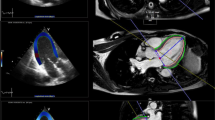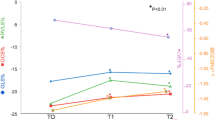Abstract
We evaluated temporal changes in early diastolic strain rates by cardiovascular magnetic resonance (CMR) as an early detector of trastuzumab-induced ventricular dysfunction. We conducted a prospective, multi-centre, longitudinal observational study of 41 trastuzumab-treated breast cancer women who underwent serial CMR (baseline, 6, 12, and 18 months). Two blinded readers independently measured left ventricular ejection fraction (LVEF), peak systolic strain parameters (global longitudinal strain [GLS] and global circumferential strain [GCS]), and early diastolic strain rate parameters (global longitudinal diastolic strain rate [GLSR-E], global circumferential diastolic strain rate [GCSR-E], and global radial diastolic strain rate [GRSR-E]), by feature tracking (FT-CMR) using CMR42. There was a significant decline in peak systolic strain GLS and GCS at 6 months (p = 0.024 and p < 0.001, respectively) and 12 months (p = 0.002 and p < 0.001, respectively), followed by recovery at 18 months, which paralleled decline in LVEF at 6 months (p = 0.034) and 12 months (p = 0.012). Conversely, early diastolic strain rates GLSR-E and GCSR-E did not significantly change over 18 months (p > 0.10), while GRSR-E was marginally significant at 12 months (p = 0.021). There was no significant correlation between changes at 6 months in LVEF and GLSR-E or GRSR-E (p > 0.10), and a marginally significant weak correlation between LVEF and GCSR-E (p = 0.046). Among trastuzumab-treated patients without overt cardiotoxicity, there was no consistent temporal change in FT-CMR-derived diastolic strain rate parameters up to 18 months, in contrast to decline in systolic strain and LVEF. Systolic strains by FT-CMR are likely more useful than diastolic strain rates for monitoring subclinical trastuzumab-related myocardial dysfunction.
ClinicalTrials.gov identifier NCT01022086.



Similar content being viewed by others
References
Moja L, Tagliabue L, Balduzzi S et al (2012) Trastuzumab containing regimens for early breast cancer. Cochrane Database Syst Rev 4:CD006243
Perez EA, Suman VJ, Davidson NE et al (2008) Cardiac safety analysis of doxorubicin and cyclophosphamide followed by paclitaxel with or without trastuzumab in the North Central Cancer Treatment Group N9831 adjuvant breast cancer trial. J Clin Oncol 26:1231–1238
Romond EH, Jeong JH, Rastogi P et al (2012) Seven-year follow-up assessment of cardiac function in NSABP B-31, a randomized trial comparing doxorubicin and cyclophosphamide followed by paclitaxel (ACP) with ACP plus trastuzumab as adjuvant therapy for patients with node-positive, human epidermal growth factor receptor 2-positive breast cancer. J Clin Oncol 30:3792–3799
Slamon D, Eiermann W, Robert N et al (2011) Adjuvant trastuzumab in HER2-positive breast cancer. New Engl J Med 365:1273–1283
Hendel RC, Berman DS, Di Carli MF et al (2009) ACCF/ASNC/ACR/AHA/ASE/SCCT/SCMR/SNM 2009 appropriate use criteria for cardiac radionuclide imaging: a report of the American College of Cardiology Foundation appropriate use criteria task force, the American Society of Nuclear Cardiology, the American College of Radiology, the American Heart Association, the American Society of Echocardiography, the Society of Cardiovascular Computed Tomography, the Society for Cardiovascular Magnetic Resonance, and the Society of Nuclear Medicine. Circulation 119:e561–e587
Cochet A, Quilichini G, Dygai-Cochet I et al (2011) Baseline diastolic dysfunction as a predictive factor of trastuzumab-mediated cardiotoxicity after adjuvant anthracycline therapy in breast cancer. Breast Cancer Res Treat 130:845–854
Sourides BE, Theofilogiannakos EK, Theofilogiannakos G et al (2007) Clinical experience from 1000 consecutive cardiovascular MRI cases at a tertiary referral medical center. Hellenic J Cardiol 48:192–197
Sengelov M, Jorgensen PG, Jensen JS et al (2015) Global longitudinal strain is a superior predictor of all-cause mortality in heart failure with reduced ejection fraction. JACC Cardiovasc Imaging 8:1351–1359
Lancellotti P, Nkomo VT, Badano LP et al (2013) Expert consensus for multi-modality imaging evaluation of cardiovascular complications of radiotherapy in adults: a report from the European Association of Cardiovascular Imaging and the American Society of Echocardiography. Eur Heart J Cardiovasc Imaging 14:721–740
Stoodley PW, Richards DA, Hui R et al (2011) Two-dimensional myocardial strain imaging detects changes in left ventricular systolic function immediately after anthracycline chemotherapy. Eur J Echocardiogr 12:945–952
Thavendiranathan P, Poulin F, Lim KD, Plana JC, Woo A, Marwick TH (2014) Use of myocardial strain imaging by echocardiography for the early detection of cardiotoxicity in patients during and after cancer chemotherapy: a systematic review. J Am Coll Cardiol 63:2751–2768
Jordan JH, Sukpraphrute B, Melendez GC, Jolly MP, D’Agostino RB Jr, Hundley WG (2017) Early myocardial strain changes during potentially cardiotoxic chemotherapy may occur as a result of reductions in left ventricular end-diastolic volume: the need to interpret left ventricular strain with volumes. Circulation 135:2575–2577
Tjeerdsma G, Meinardi MT, van Der Graaf WT et al (1999) Early detection of anthracycline induced cardiotoxicity in asymptomatic patients with normal left ventricular systolic function: autonomic versus echocardiographic variables. Heart 81:419–423
Downes TR, Nomeir AM, Smith KM, Stewart KP, Little WC (1989) Mechanism of altered pattern of left ventricular filling with aging in subjects without cardiac disease. Am J Cardiol 64:523–527
Zabalgoitia M, Rahman SN, Haley WE, et al. (1998) Comparison in systemic hypertension of left ventricular mass and geometry with systolic and diastolic function in patients < 65 to> or = 65 years of age. Am J Cardiol. 82:604–608.
Tassan-Mangina S, Codorean D, Metivier M et al (2006) Tissue Doppler imaging and conventional echocardiography after anthracycline treatment in adults: early and late alterations of left ventricular function during a prospective study. Eur J Echocardiogr 7:141–146
Ong G, Brezden-Masley C, Dhir V et al (2018) Myocardial strain imaging by cardiac magnetic resonance for detection of subclinical myocardial dysfunction in breast cancer patients receiving trastuzumab and chemotherapy. Int J Cardiol 261:228–233
Barthur A, Brezden-Masley C, Connelly KA et al (2017) Longitudinal assessment of right ventricular structure and function by cardiovascular magnetic resonance in breast cancer patients treated with trastuzumab: a prospective observational study. J Cardiovasc Magn Reson 19:44
Mackey JR, Clemons M, Cote MA et al (2008) Cardiac management during adjuvant trastuzumab therapy: recommendations of the Canadian Trastuzumab Working Group. Curr Oncol 15:24–35
Tee M, Noble JA, Bluemke DA (2013) Imaging techniques for cardiac strain and deformation: comparison of echocardiography, cardiac magnetic resonance and cardiac computed tomography. Expert Rev Cardiovasc Ther 11:221–231
Hor KN, Baumann R, Pedrizzetti G et al (2011) Magnetic resonance derived myocardial strain assessment using feature tracking. J Vis Exp 2011:2356–2361
Claus P, Omar AMS, Pedrizzetti G, Sengupta PP, Nagel E (2015) Tissue tracking technology for assessing cardiac mechanics: principles, normal values, and clinical applications. JACC Cardiovasc Imaging 8:1444–1460
Taylor RJ, Moody WE, Umar F et al (2015) Myocardial strain measurement with feature-tracking cardiovascular magnetic resonance: normal values. Eur Heart J Cardiovasc Imaging 16:871–881
Lange SA, Ebner B, Wess A et al (2012) Echocardiography signs of early cardiac impairment in patients with breast cancer and trastuzumab therapy. Clin Res Cardiol 101:415–426
Reuvekamp EJ, Bulten BF, Nieuwenhuis AA et al (2016) Does diastolic dysfunction precede systolic dysfunction in trastuzumab-induced cardiotoxicity? Assessment with multigated radionuclide angiography (MUGA). J Nucl Cardiol 23:824–832
Axel L, Dougherty L (1989) MR imaging of motion with spatial modulation of magnetization. Radiology 171:841–845
Kraitchman DL, Sampath S, Castillo E et al (2003) Quantitative ischemia detection during cardiac magnetic resonance stress testing by use of FastHARP. Circulation 107:2025–2030
Osman NF, Prince JL (2000) Visualizing myocardial function using HARP MRI. Phys Med Biol 45:1665–1682
Yan AT, Yan RT, Cushman M et al (2010) Relationship of interleukin-6 with regional and global left-ventricular function in asymptomatic individuals without clinical cardiovascular disease: insights from the Multi-Ethnic Study of Atherosclerosis. Eur Heart J 31:875–882
Hor KN, Gottliebson WM, Carson C et al (2010) Comparison of magnetic resonance feature tracking for strain calculation with harmonic phase imaging analysis. JACC Cardiovasc Imaging 3:144–151
Kuetting D, Sprinkart AM, Doerner J, Schild H, Thomas D (2015) Comparison of magnetic resonance feature tracking with harmonic phase imaging analysis (CSPAMM) for assessment of global and regional diastolic function. Eur J Radiol 84:100–107
Moody WE, Taylor RJ, Edwards NC et al (2015) Comparison of magnetic resonance feature tracking for systolic and diastolic strain and strain rate calculation with spatial modulation of magnetization imaging analysis. J Magn Reson Imaging 41:1000–1012
Hare JL, Brown JK, Leano R, Jenkins C, Woodward N, Marwick TH (2009) Use of myocardial deformation imaging to detect preclinical myocardial dysfunction before conventional measures in patients undergoing breast cancer treatment with trastuzumab. Am Heart J 158:294–301
Ho E, Brown A, Barrett P et al (2010) Subclinical anthracycline- and trastuzumab-induced cardiotoxicity in the long-term follow-up of asymptomatic breast cancer survivors: a speckle tracking echocardiographic study. Heart 96:701–707
Negishi K, Negishi T, Hare JL, Haluska BA, Plana JC, Marwick TH (2013) Independent and incremental value of deformation indices for prediction of trastuzumab-induced cardiotoxicity. J Am Soc Echocardiogr 26:493–498
Plana JC, Galderisi M, Barac A et al (2014) Expert consensus for multimodality imaging evaluation of adult patients during and after cancer therapy: a report from the American Society of Echocardiography and the European Association of Cardiovascular Imaging. J Am Soc Echocardiogr 27:911–939
Nakano S, Takahashi M, Kimura F et al (2016) Cardiac magnetic resonance imaging-based myocardial strain study for evaluation of cardiotoxicity in breast cancer patients treated with trastuzumab: a pilot study to evaluate the feasibility of the method. Cardiol J 23:270–280
Fallah-Rad N, Walker JR, Wassef A et al (2011) The utility of cardiac biomarkers, tissue velocity and strain imaging, and cardiac magnetic resonance imaging in predicting early left ventricular dysfunction in patients with human epidermal growth factor receptor II-positive breast cancer treated with adjuvant trastuzumab therapy. J Am Coll Cardiol 57:2263–2270
Vo HQ, Marwick TH, Negishi K (2018) MRI-derived myocardial strain measures in normal subjects. JACC Cardiovasc Imaging 11:196–205
Bulten BF, Mavinkurve-Groothuis AM, de Geus-Oei LF et al (2014) Early myocardial deformation abnormalities in breast cancer survivors. Breast Cancer Res Treat 146:127–135
Ambale-Venkatesh B, Armstrong AC, Liu CY et al (2014) Diastolic function assessed from tagged MRI predicts heart failure and atrial fibrillation over an 8-year follow-up period: the multi-ethnic study of atherosclerosis. Eur Heart J Cardiovasc Imaging 15:442–449
Acknowledgements
This study was funded by an operating grant from the Canadian Institutes of Health Research (CIHR) and Roche. We thank all the patients who participated in this study, the study coordinators, and Rosane Nisenbaum for her assistance in data management. Dr Kim A. Connelly is supported by a New Investigator award from the CIHR and an Early Researcher award from the Ministry of Ontario. Dr. Yan is supported by a Clinician-Scientist Award from the University of Toronto. Dr. Thavendiranathan is supported by a New Investigator Award from the CIHR.
Author information
Authors and Affiliations
Corresponding author
Ethics declarations
Conflict of interest
C. Brezden-Masley has received research grant support and/or honoraria for educational activities and/or served as consultant to Roche.
Electronic supplementary material
Below is the link to the electronic supplementary material.
Rights and permissions
About this article
Cite this article
Gong, I.Y., Ong, G., Brezden-Masley, C. et al. Early diastolic strain rate measurements by cardiac MRI in breast cancer patients treated with trastuzumab: a longitudinal study. Int J Cardiovasc Imaging 35, 653–662 (2019). https://doi.org/10.1007/s10554-018-1482-2
Received:
Accepted:
Published:
Issue Date:
DOI: https://doi.org/10.1007/s10554-018-1482-2




